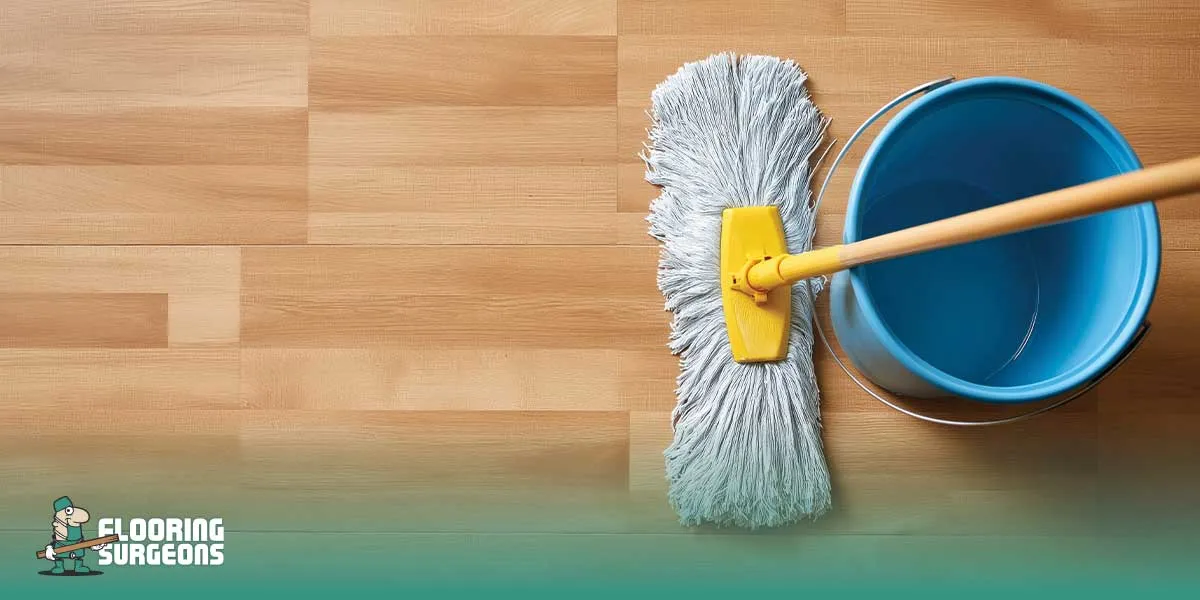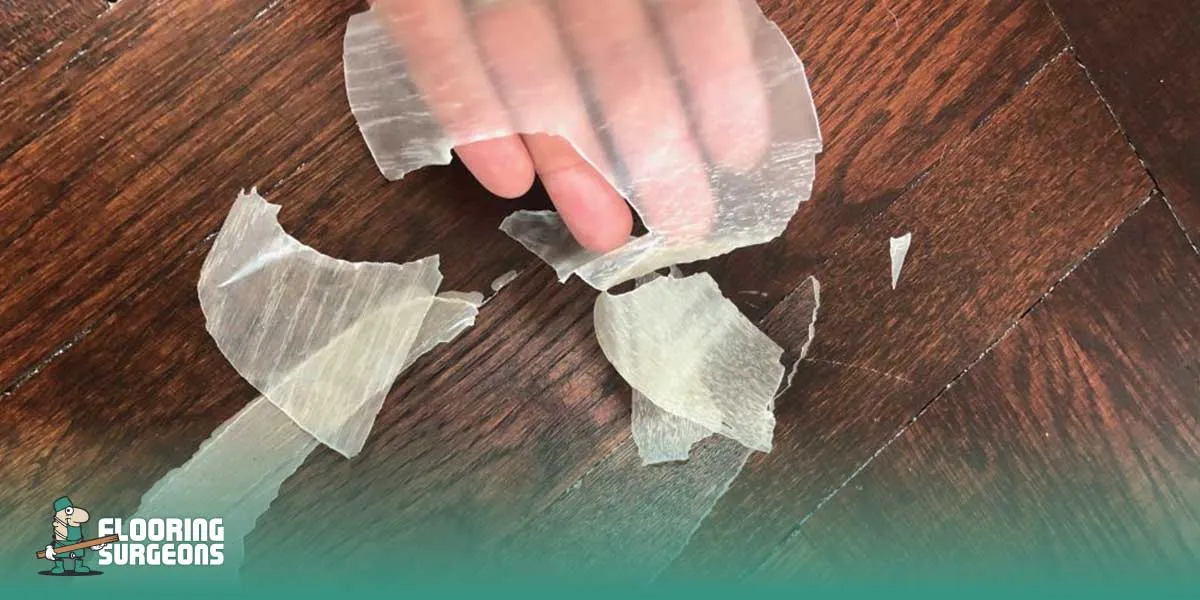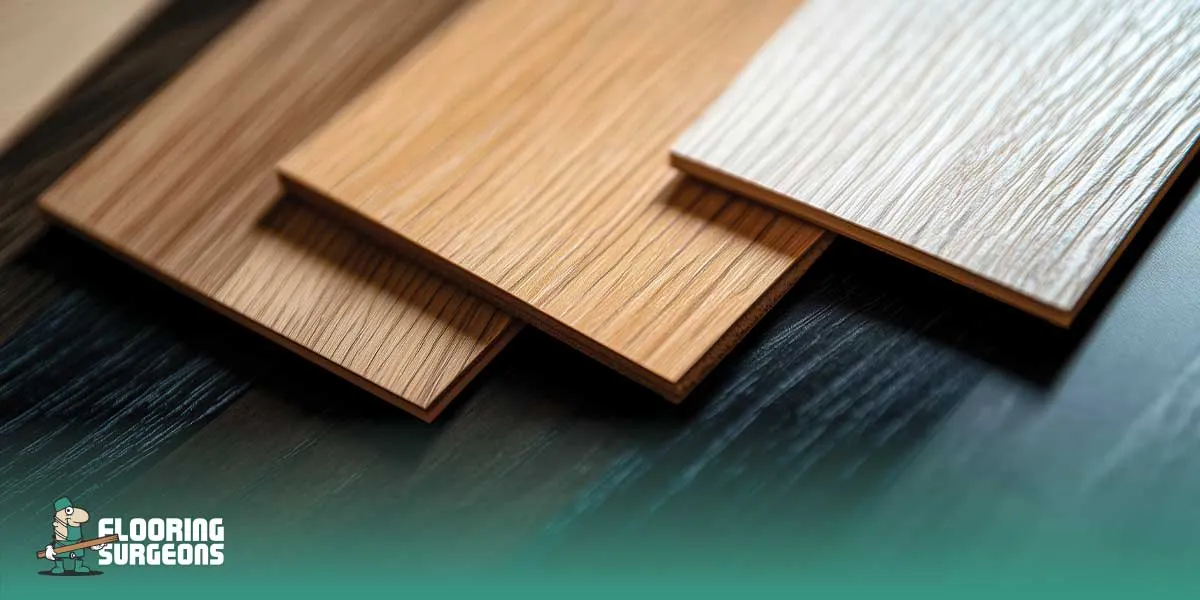Laminate flooring gives you the timeless beauty of wood but keeping it spotless requires a more innovative approach than you might think. Learning how to clean laminate flooring properly not only preserves its natural shine but also prevents swelling, streaks, or dull patches caused by excess moisture.
In this guide, we’ll walk you through expert-approved cleaning techniques from daily dust control to deep-cleaning methods and natural home solutions so your laminate floors always look as flawless as the day they were installed. Whether you have classic oak, Pergo, or waterproof laminate, the tips below will help you maintain both appearance and durability for years to come.
How Often Should You Clean Laminate Flooring?
Knowing how often to clean laminate flooring is the key to keeping it looking fresh without wearing down the surface. Laminate doesn’t need constant scrubbing just the right balance of daily care and occasional deep cleaning.
Here’s a simple schedule to follow:
- Daily: Light sweeping or dry mopping to remove dust, pet hair, and grit that can cause tiny scratches.
- Weekly: Vacuum on the hard-floor setting to clean corners and edges where debris tends to collect.
- Every 2–4 Weeks: Perform a light deep clean using a microfiber mop and a laminate-safe solution.
Avoid over-mopping or leaving standing water behind. Because laminate has a fibrous core, excess moisture can seep between planks, leading to swelling, warping, or separation over time. Homes with kids, pets, or high foot traffic may need more frequent cleaning. For commercial-grade or waterproof laminate options, Flooring Surgeons’ collections are designed to handle heavier use with minimal maintenance.
Best Tools and Products to Properly Clean Laminate Floors Without Damage
To master cleaning laminate flooring properly, you’ll need the right tools that protect its finish while delivering a streak-free shine. Using harsh materials or incorrect products can dull the surface or even cause swelling over time so choose your essentials carefully.
Core Cleaning Tools
- Soft-Bristled Broom or Microfibre Dust Mop: Perfect for daily dusting and removing grit without scratching the surface.
- Vacuum Cleaner (Hard-Floor Mode): Helps reach corners and edges, especially under furniture or along skirting boards.
- Microfibre Mop or Spray Mop: Delivers light, even moisture ideal for gentle weekly cleaning.
Cleaning Solutions & Accessories
- pH-Neutral Laminate Cleaner: Always use a laminate-safe, non-abrasive solution. Avoid bleach or ammonia-based products.
- Warm Water Bucket & Microfibre Cloths: For spot-cleaning and quick drying to prevent streaks.
- Optional: A dry towel or fan to speed up drying after mopping.
Pro Tip from Flooring Surgeons:
For the best results, use laminate-safe microfibre mops they trap fine dust particles effectively while keeping your floors scratch-free. If you prefer store-bought products, look for pH-neutral cleaners specifically labelled for laminate or Pergo floors.

Daily Care Tips | How to Clean Laminate Floors the Right Way
Keeping your floors spotless doesn’t require much effort just consistency. Here’s how to clean laminate floors every day to maintain their shine and durability:
1. Wipe Spills Immediately: Act fast with dark liquids like coffee, tea, or wine. The longer a spill sits, the higher the chance it seeps between the boards. Use a soft microfibre cloth and gently blot (never rub) to prevent spreading.
2. Sweep or Dust Mop Daily: Use a soft-bristled broom or microfibre dust mop to pick up everyday dust and pet hair. These tools trap debris without scratching your laminate’s surface.
3. Vacuum Once or Twice a Week: If you prefer vacuuming, make sure to use a hard floor setting and avoid rotating brushes. Always move in the direction of the floorboards this keeps dirt from collecting in the joints.
4. Keep Entry Points Clean: Place doormats at entrances to reduce the amount of grit brought inside. Less grit = fewer micro-scratches over time.
For quick daily cleaning, a microfibre spray mop with minimal water is ideal. It picks up fine dust and keeps your laminate floors looking freshly installed without risking swelling or streaks.
For more expert flooring tips and maintenance guidance, check out our complete guide on Flooring Adhesive to ensure your laminate floors stay strong and beautifully installed.
Homemade Cleaning Solutions for Laminate Wood Floors
- Vinegar Rinse (for general grime & water spots): Mix 1 cup white vinegar with 1 gallon (≈4 L) of warm water. Lightly mist a microfiber cloth/mop (don’t soak), wipe the area, then dry immediately. Tip: Overuse of acid can dull some finishes use sparingly.
- Mild Soap for Grease: Add a few drops of pH-neutral dish soap to a bucket of warm water. Dampen a microfiber cloth, lift the grease, then wipe with a plain, damp cloth and dry.
- Baking Soda Paste (for sticky residue/scuffs): Combine 1 tbsp baking soda + a few drops of water to a soft paste. Apply gently with a microfiber cloth in small circles, wipe clean, and dry.
- Rubbing Alcohol (70% isopropyl) Spot Treatment: For ink/marker or cosmetics, dab a cloth with alcohol, blot gently, then neutralize with a slightly damp cloth and dry.
Never use: bleach, ammonia, abrasive powders/pads, steam mops, or wax/polish products on laminate.
How to Clean Tough Stains Like Food, Oil, and Ink
- Food & Dye Stains (coffee, tea, wine, tomato):
- Blot immediately with a dry microfiber cloth.
- Lightly apply the vinegar rinse and continue blotting don’t flood the area.
- Wipe with a barely damp cloth to remove residue, then dry thoroughly (fan helps prevent streaks).
- Oil & Grease (cooking splatters, oily fingerprints):
- Apply a mild soap solution to a microfiber cloth and gently lift the film.
- If a slick residue remains, spot-treat with a tiny amount of rubbing alcohol.
- Wipe with a clean, slightly damp cloth and dry thoroughly.
- Ink, Marker, Shoe Polish, Cosmetics:
- Moisten a microfiber cloth with 70% isopropyl alcohol.
- Blot don’t rub until pigment transfers to the cloth.
- Finish with a damp wipe, then immediately dry.
- Nail Polish / Varnish (use with caution):
- Spot-dab a cloth with a small amount of acetone-based nail-polish remover.
- Touch the stain briefly, lift, and repeat as needed don’t let it sit.
- Neutralize with a damp cloth and dry at once. (Test first; acetone can dull some finishes.)
- Gum, Wax, or Sticky Residue:
- Place an ice pack over the spot for a few minutes to harden.
- Lift gently with a plastic scraper (never a metal one).
- Clean any film with the mild soap solution and dry.
After any spot treatment, run a dry microfiber towel over the area to eliminate moisture and help prevent streaks or film especially on darker laminate tones.
For even better protection and long-term performance, consider upgrading your subfloor with Flooring Underlay for Laminate Flooring the right underlay makes all the difference in durability, noise reduction, and overall floor quality.
| Stain Type | How to Clean (Short Steps) | Key Tips |
|---|---|---|
| Food & Dye Stains (coffee, tea, wine, tomato) | Blot dry → Light vinegar touch-up → Wipe with a barely damp cloth → Dry fully | Avoid oversaturating to prevent streaks. |
| Oil & Grease | Clean with mild soap solution → If slick, use a tiny bit of rubbing alcohol → Damp wipe → Dry | Use alcohol sparingly to protect the finish. |
| Ink, Marker, Shoe Polish, Cosmetics | Apply 70% isopropyl alcohol to cloth → Blot until pigment lifts → Damp wipe → Dry | Never rub—prevents spreading. |
| Nail Polish / Varnish (with caution) | Lightly dab with acetone remover → Lift repeatedly → Damp wipe → Dry immediately | Test first; acetone can dull surfaces. |
| Gum, Wax, Sticky Residue | Harden with ice → Lift with plastic scraper → Clean remaining film with mild soap → Dry | Avoid metal scrapers to prevent scratches. |
| Final Step | Run a dry microfiber cloth over cleaned area | Helps eliminate moisture and streaking. |
How to Deep Clean Laminate Flooring Without Damage
Even with regular maintenance, laminate floors occasionally need a deeper clean to restore their shine and remove built-up grime. The key is using minimal moisture and non-abrasive products too much water or the wrong cleaner can cause swelling, fading, or dull spots. Here’s how to deep-clean laminate flooring without damaging it, step by step.
Step 1: Prepare the Floor
Start by vacuuming or dry-mopping to remove surface dust, hair, and grit. This prevents scratches while mopping and ensures you’re cleaning dirt, not grinding it in.
Step 2: Mix a Safe Deep-Cleaning Solution
Skip harsh chemicals instead, make a gentle homemade cleaner that’s effective yet laminate-safe:
- Mix: 1 cup white vinegar with 1 gallon (≈4 L) of lukewarm water.
- Optional: Add a teaspoon of mild dish soap for extra cleaning power.
Lightly mist a microfiber mop (never soak it), then glide across the floor in sections following the plank direction. Rinse the mop frequently and wring it out well each time.
Never pour the solution directly on the floor. A fine mist is all you need laminate planks should never look wet.
Step 3: Tackle Stubborn Spots and Sticky Residue
- Gum or wax: Place an ice pack on the spot until it hardens, then lift gently with a plastic scraper.
- Oil or grease marks: Start with a cloth dampened with a mild pH-neutral cleaner or a tiny amount of rubbing alcohol. Avoid strong solvents like acetone unless specifically recommended by the flooring manufacturer.
- Ink or permanent marker: Dab gently with rubbing alcohol on a soft cloth. Always test in a hidden area first to avoid discolouration.
Step 4: Dry Thoroughly
After deep cleaning, dry the floor immediately using a clean, dry microfiber mop or towel. You can speed up drying by using a fan or opening windows. Avoid walking on the floor until it’s completely dry to prevent streaks or impressions.
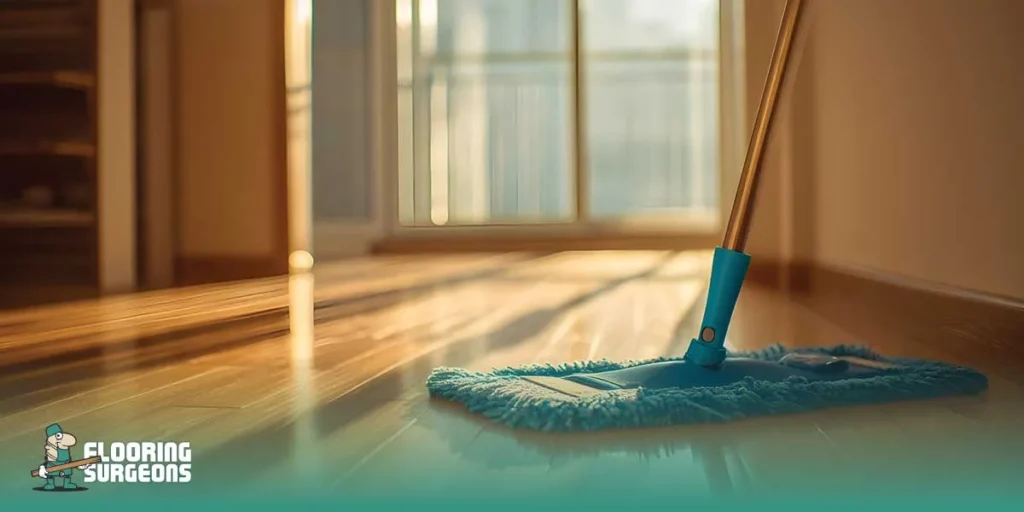
Best Natural Way to Clean Laminate Hardwood Floors
If you prefer a chemical-free routine, the best way to clean laminate hardwood flooring naturally is to focus on mild, plant-based ingredients that protect the finish while keeping your home safe for kids and pets. Laminate doesn’t need harsh detergents to shine it just needs competent, gentle care.
Simple Natural Cleaning Mix
- Vinegar & Water: Combine 1 cup of distilled white vinegar with 4 litres of warm water. Lightly mist onto the floor using a spray bottle, then wipe with a microfiber mop.
- Baking Soda Paste: For sticky spots or food stains, apply a small amount of baking soda paste made with water, rub gently with a soft cloth, and rinse.
- Lemon Water (optional): Add a few drops of lemon juice for a fresh scent completely safe for laminate surfaces.
Always test any natural cleaner in a corner first. Even eco-friendly mixes can dull specific laminate finishes if left too long.
How to Clean Pergo and Waterproof Laminate Flooring?
Pergo and waterproof laminate flooring are designed to resist spills, but they still need the proper cleaning routine to preserve the protective top layer. Here’s how to clean them safely:
- Dust or Vacuum First: Use a soft broom or vacuum with a hard-floor setting to remove grit.
- Damp Mop Lightly: Use a microfiber mop dampened with a pH-neutral or laminate-safe cleaner (not soaked).
- Focus on Seams: Wipe along the plank’s length to prevent water from pooling in joints.
- Dry Immediately: Even waterproof laminate shouldn’t stay wet for long always dry with a clean towel.
Avoid steam mops, abrasive pads, or wax-based polishes. They can break down the waterproof seal over time.
If you’re using Flooring Surgeons‘ waterproof laminate collections, the same steps apply: minimal moisture, quick drying, and only gentle cleaners.
Cleaning Laminate Floors with Vinegar | Does It Really Work?
Many homeowners swear by vinegar as an eco-friendly cleaner, but how to clean laminate flooring with vinegar correctly is all about moderation. Vinegar can dissolve residue and kill bacteria, but excessive acidity can dull the surface finish.
Correct Way to Use Vinegar
- Mix 1 cup of vinegar with 1 gallon of warm water.
- Lightly dampen a microfiber mop don’t pour or oversaturate.
- Mop following the plank direction for even shine.
- Immediately dry the surface with a clean towel.
Works best for: water spots, footprints, and light film build-up.
Avoid for: waxed, high-gloss, or oil-treated laminate surfaces.
Always use white distilled vinegar never apple cider or flavoured versions. These may leave sticky residues or discolour light floors.
Advantages of Using Vinegar on Laminate Flooring
- Natural Disinfectant: Effectively removes bacteria and odours without chemicals.
- Streak-Free Finish: Cuts through soap film and greasy buildup.
- Budget-Friendly: Cheaper than store-bought cleaners while equally effective for light cleaning.
- Eco-Safe: Non-toxic and safe for families with children or pets.
Just remember the advantage of vinegar lies in light use. When overused or applied too wet, it can weaken protective coatings. Moderation keeps your laminate flooring clean, fresh, and naturally bright for years.
How to Clean Paint Spills Off Laminate Flooring?
Paint accidents happen but the good news is, laminate flooring can handle them if you act quickly and carefully. Here’s how to clean paint off laminate flooring without scratching or dulling the surface.
For Wet Paint:
- Blot the spill immediately with a microfiber towel don’t spread it.
- Dampen a soft cloth with warm water and mild dish soap, and gently lift the colour.
- Rinse the cloth often and dry the area thoroughly once the paint is gone.
For Dried Paint:
- Soften it first by laying a warm, damp cloth over the spot for 5–10 minutes.
- Once softened, gently lift the residue with a plastic scraper never use metal blades.
- If residue remains, use a drop of rubbing alcohol or acetone on a cloth and dab gently.
- Wipe again with a damp cloth and immediately dry.
Never scrape aggressively. Let the cleaner loosen the paint your goal is to lift, not grind. After cleaning, a quick buff with a dry microfiber pad will restore your floor’s natural shine.
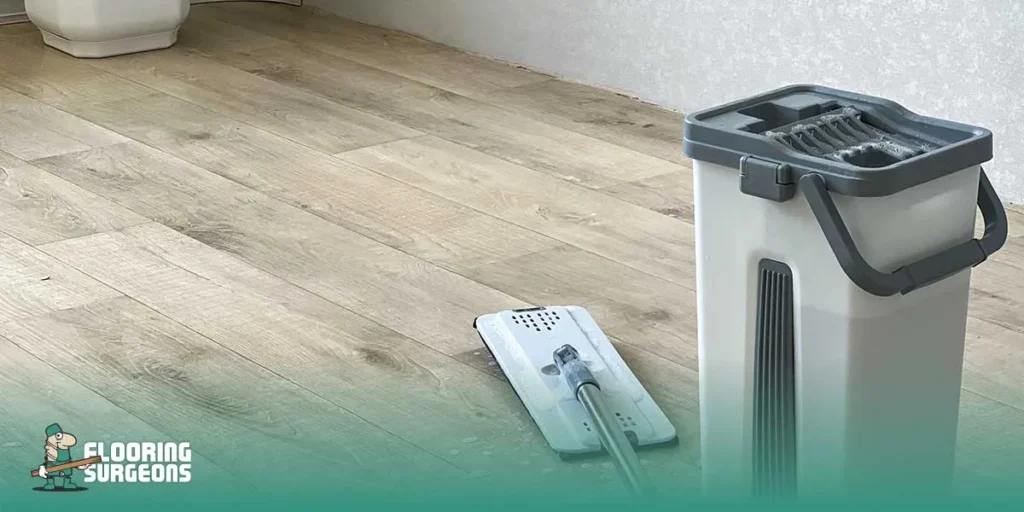
How to Maintain Laminate Flooring for Long-Term Durability
Laminate flooring is built to last, but consistent care keeps it looking its best for decades. Here’s how to maintain laminate flooring and prevent damage before it starts.
Long-Term Maintenance Checklist
- Avoid harsh cleaners: Skip bleach, wax, and ammonia. Use only pH-neutral, laminate-safe products.
- Protect high-traffic zones: Use rugs or mats near doors and under furniture.
- Add felt pads to furniture legs to prevent scratches when moving chairs or tables.
- Control sunlight exposure: Prolonged UV can fade laminate; close blinds during peak hours.
- Trim pet nails: Pet scratches are among the most common surface damage.
- Use doormats: Keep out grit, sand, and small stones that can abrade the finish.
Our laminate collections include durable UV-protected coatings, but following these simple steps extends both their life and warranty coverage.
For more expert guidance on keeping all types of flooring in top condition, explore our full guide on Tips to clean engineered wood floors and elevate your floor care routine even further.
How to Keep Laminate Floors Clean Between Deep Cleanings
You don’t need to deep-clean every week instead, learn how to best clean laminate flooring between sessions to keep it spotless day to day.
Quick Maintenance Tips
- Dust daily with a dry microfiber mop or electrostatic duster.
- Spot-clean spills immediately with a damp cloth, then dry thoroughly.
- Vacuum weekly using a hard-floor setting to capture fine dust in joints.
- Wipe with vinegar mix (1 cup vinegar + 1 gallon water) every two weeks for a natural refresh.
- Dry always: Moisture is laminate’s enemy air-dry or towel-dry right after mopping.
For extra protection, apply a laminate care spray every 2–3 months. It adds a thin anti-static layer that helps repel dust and keep your floors cleaner for longer.
How to Mop Laminate Hardwood Floors Without Water Damage
Knowing how to mop laminate hardwood floors safely is crucial too much water can cause swelling or peeling at the edges. Follow this moisture-control method:
Step-by-Step Safe Mopping Technique
- Use the right mop: Choose a microfiber spray mop never a string mop or sponge mop.
- Wring thoroughly: Your mop should be barely damp, not dripping.
- Work in sections: Mop in plank direction to prevent water from pooling in seams.
- Dry instantly: Follow immediately with a clean, dry microfiber pad or towel.
Avoid steam mops they push hot moisture beneath the laminate, causing permanent warping.
For the most water-resistant results, choose our Waterproof Laminate Range, designed with tight-locked joints and hydrophobic coatings. Even so, always mop lightly prevention is key.
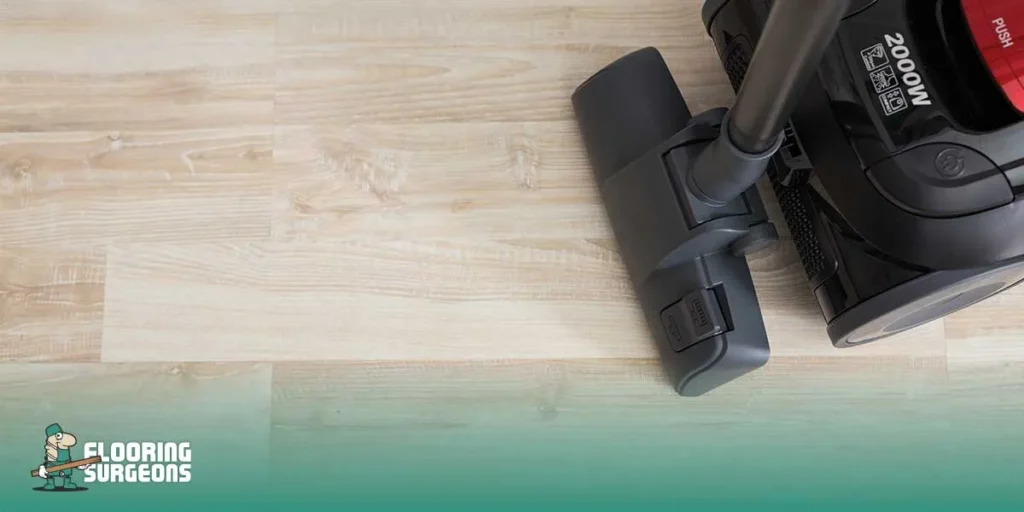
How to Wash Laminate Flooring the Right Way in the UK?
In the UK, many regions have hard water, which can leave mineral streaks and dull your floor’s finish. Here’s how to wash laminate floors properly using local-friendly methods:
- Use softened water if possible (filtered or distilled water prevents streaks).
- Mix white vinegar with warm water (1:4 ratio) or use Astonish/Ecover pH-neutral laminate cleaner both are UK-available and safe.
- Lightly mist your mop never pour and clean in long, even strokes.
- Immediately dry with a towel to avoid limescale marks.
In hard-water areas (London, Birmingham, Manchester), add one teaspoon of distilled vinegar to your mop water to neutralize minerals and prevent cloudiness. Flooring Surgeons’ UK-approved cleaning range is formulated for precisely this purpose.
Step-by-Step Guide | How to Properly Clean Laminate Floors
Learning how to properly clean laminate flooring isn’t complicated, but the proper process makes all the difference between dull and dazzling results. Follow this step-by-step guide to keep your laminate floors in perfect condition without risking water damage or streaks.
- Step 1 – Clear the Area: Remove rugs, chairs, and other movable furniture to create a clean workspace. This prevents trapped dust or missed spots along edges.
- Step 2 – Dry Cleaning First: Use a soft-bristled broom, microfiber dust mop, or vacuum on a hard-floor setting to pick up dust, pet hair, and grit. Never skip this step – dry cleaning first prevents scratches.
- Step 3 – Prepare a Laminate-Safe Solution: Mix 1 cup white vinegar or a few drops of a mild pH-neutral cleaner into a gallon of lukewarm water. Avoid soaps that leave a film or residue.
- Step 4 – Damp Mop Gently: Wring your mop thoroughly so it’s barely damp, not wet. Move along the grain of the planks in even strokes. Do not let water pool or sit on the surface.
- Step 5 – Spot Treat Stains: Use rubbing alcohol for ink or oil, or baking soda paste for sticky marks. Always wipe clean afterward with a damp cloth.
- Step 6 – Rinse (Optional): If your cleaner leaves any residue, rinse the mop and go over the floor once more with plain water again, with minimal moisture.
- Step 7 – Dry Immediately: Use a dry microfiber cloth or towel to remove any remaining moisture. Allow proper ventilation or switch on a fan for faster drying.
Never use steam mops or wax-based polishes on laminate floors. Steam causes swelling between planks, while wax can create a slippery film that dulls the finish over time.
For a faster, streak-free, and laminate-safe cleaning routine, upgrade your toolkit with the WOCA Maintenance Cleaning Spray Mop for Wood, Laminate & LVT Vinyl Flooring and experience a noticeably better clean with every use:
https://www.flooringsurgeons.co.uk/product/woca-cleaning-spray-mop-for-wood-laminate-vinyl-flooring/
Keep Your Laminate Floors Looking New with Flooring Surgeons
Keep your laminate floors looking stunning year after year with expert guidance and premium materials from Flooring Surgeons. Explore our full range of laminate flooring collections, including waterproof, Pergo-style, and natural wood designs all built for durability, style, and easy maintenance.
Whether you’re renovating a single room or upgrading your entire home, our specialists can help you choose the right laminate for your lifestyle and show you the best ways to care for it. Visit our Birmingham or Wolverhampton showrooms, or browse online to request free samples and get personalized advice from our flooring experts. Flooring Surgeons – where design meets durability, and every floor stays beautiful for years to come.


